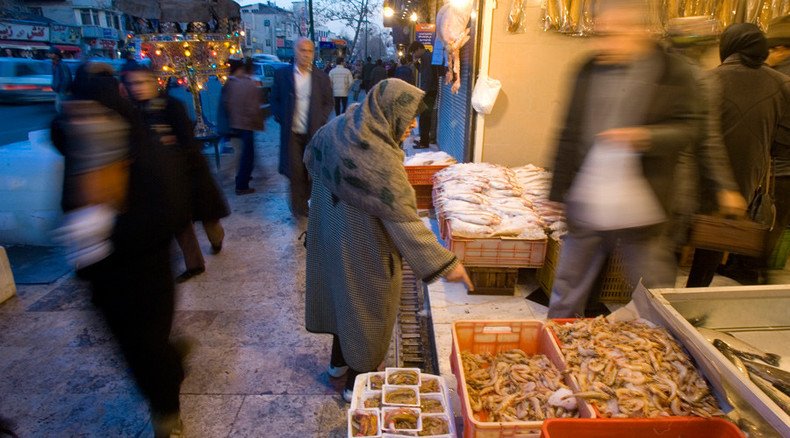Persia's approaching gold rush

You may have heard of the N-11. Yes, it’s another clever Goldman Sachs concoction, to the benefit of that prized specimen - the “global investor”. These are the next BRICS, the new emerging powers.
The N-11 is made up of: Bangladesh, Egypt, Indonesia, Iran, South Korea, Mexico, Nigeria, Pakistan, Philippines, Turkey and Vietnam. Some of these upstarts may even become members of the increasingly assertive BRICS.
The moment the sanctions regime vanishes, arguably sometime in early 2016, Iran will become the hottest N-11 in the world. It’s very hard to beat its roll call of assets: a consumer market of more than 80 million, largely well educated people; a human capital mix that is even more attractive than Turkey; and in the all-important energy front, a combination of as much oil as Saudi Arabia, as much gas as Russia, and arguably more mineral resources than Australia.
And soon back with a vengeance in the global market. Talk about an economic game-changer.
Join the caravan
Even under a nasty UN/US/EU package of sanctions – which Tehran always qualified as unlawful and unjust - Iran has built the most solid industrial base in Southwest Asia. It ranks, for instance, among the Top 15 global steel producers and Top 15 global car manufacturers. It is the worlds’ top exporter of cement, pistachios, saffron and caviar.
READ MORE: Iran nuclear deal gets UN endorsement, paving way for sanctions relief
Iran is well positioned among global leaders in nanotechnology and stem cell research. It is the certified scientific power in Southwest Asia; the 17th largest producer of scientific papers in the world – ahead of Turkey and Israel. Not to mention Saudi Arabia, that global leader of, well, beheadings.
As the sanctions vanish, Iran will be able to boost its already sprawling industrial and scientific infrastructure. It will be a quest for selected Western technology. For the moment, technology breakthroughs come from BRICS member-nations China, Russia and India.
The Lausanne agreement was barely inked when a global corporate caravan - spanning Europe to Asia – began hitting the Persian trail, positioning themselves for the grand (re)opening of the Iranian bazaar.
On energy, that included European giants Royal Dutch Shell and Eni, French ambassador to the US Gerard Araud was forced to placate hawks at the Atlantic Council think tank with an obvious fact; “Really, we lost a lot of money, not the Americans,” Araud noted as European companies were forced to abide by US-concocted sanctions. He added, “so stop taking the moral high ground.”
Russian envoys, for their part, had already been crisscrossing Iran for months, exchanging political, economic and military data. Russian-Iranian relations, extremely nuanced, are based on pragmatism.
READ MORE: Key points of historic nuclear deal reached by Iran and 6 world powers
The concrete possibility of Iran starting to sell huge amounts of gas to the EU is of course a very sensitive subject for Moscow – especially because this new drive is pushed by Washington. Yet for Russia, that may be a relatively short-term risk, up to 2020 at most, because in the long run Gazprom’s top business will be with China – and the rest of Asia. Five years is what it takes to build and expand the ‘Pipelineistan’ network across Siberia towards China.
And there’s always a Chinese-style “win-win” at hand; as the conventional arms embargo progressively vanishes, Tehran will be buying more Russian weapons, not only the S-400 missile system.
Boeing or Airbus?
Post-sanctions, Iran will take maximum advantage of one of its key assets; location, location, location. Iran is nothing else but the privileged crossroads/trade hub connecting Europe, Central Asia, the Caucasus and Southwest Asia – what the West calls the Middle East. It’s right at the center of the Chinese-led New Silk Roads, and an ideal candidate to join the Eurasian Economic Union (EEU) – increasing trade with Central Asia, as in Kazakhstan and Kyrgyzstan.
Iran, Afghanistan and Tajikistan even share a common language – Persian and its derivations, Dari and Tajik. Countries bordering Iran – from Afghanistan and Armenia to Turkey and Turkmenistan – will see an immediate trade surge; after all sanctions never managed to stop cross-border trade.
READ MORE: Iran signs oil contracts for 2015, aims at pre-sanctions capacity in Europe
A boom in the Iranian tourism industry is inevitable – involving a rush of customers from Europe to Asia and all points in between. The shipping industry – already in good shape – will prosper. And of course there will be a pressing need for a lot of passenger jets.
One of the most perverse consequences of US-driven sanctions is that for decades, Iranian carriers were forced to source and repair their jets from the black market. And until recently just two months before the Vienna deal was signed, we had the case of Mahan Air, Iran’s second largest carrier, having to resort to an Iraq-based front company to buy nine Airbuses.
Iran now needs no less than 400 passenger jets over the next decade. Iran Air's chairman, Farhad Parvaresh, is interested not only in both Boeings 777 and 787, but also the Airbus A321. And he does not discount the new 747-8, which has been a hard sell for Boeing.
Now imagine Iranian carriers expanding their flights to a slew of European and Asian capitals. That will provide serious competition to Turkish Airlines, Emirates, Etihad and Qatar Airways, attracting everyone who lives and works everywhere from Central Asia to the Caucasus.
It’s a gas, gas, gas
Iran will soon be back to its pre-2012 level of oil exports; 2.5 million barrels a day. At the moment, it’s down to 1.5 million barrels a day – due to Washington’s relentless campaign to arm-twist Iranian energy customers such as South Korea, Japan and the EU. China, still growing at 7 percent a year, will remain the customer of choice. And by 2018, with other major Asian economies such as India and Indonesia picking up growth, Iran’s exports will definitely surge.
READ MORE: Skeptics, snapbacks & Netanyahu: How Iran nuclear deal could still be derailed
According to National Iranian Oil Company (NIOC) estimations, Tehran is ready to add from at least 600,000 to up to 1 million barrels of oil a day to the global market. This means prices going further down in the foreseeable future – which benefits non-oil producers with huge populations such as Pakistan and Egypt.
From a Pakistani angle, this will translate into the conclusion of one of ‘Pipelinestan’s’ eternal soap operas; the IP (Iran-Pakistan) gas pipeline. The Pakistani stretch is being financed by China. From an Egyptian angle, this will translate into lower transportation costs and more traffic through the Suez Canal.
The United Arab Emirates (UAE) is a more complex proposition. Dubai will profit handsomely, as it is already an Iranian trade/commercial/banking center where tens of billions of US dollars in Iranian funds are parked. Yet Iran’s energy offensive will be focused essentially on regaining market share from its Persian Gulf competitors, including the UAE. Add to it that Saudi Arabia’s reserves are slowly but surely diminishing – as it is spending its oil capital to bomb Yemen.
Everywhere we look Eurasia integration – with Iran as a protagonist - proceeds unabated.
Iranian President Hassan Rouhani met with Indian Prime Minister Narendra Modi at the sidelines of the BRICS/SCO summit in Ufa. Rouhani expects India to invest $8 billion in key infrastructure projects – centered on the development of the strategic port of Chabahar in the Gulf of Oman. India is already leasing two berths at the port, using them as multi-purpose cargo terminals. Next step is to help building the second and third terminals as well as a railway connecting it to the rest of Iran.
Chabahar will be not only India’s gateway to Central Asia, but it will also open a sea route to landlocked Afghanistan. Both India and Iran are very active in Afghanistan – in both the commercial and security fronts.
The Syrian tangle
One of the worst kept “secrets” in Brussels has always been the EU’s burning desire to do energy business with Iran. According to European Parliament numbers, Iran may soon export more than 150 billion cubic meters (bcm) of gas a year. Compare it to Gazprom’s current export total of 140bcm to the EU.
Iran’s are the second-largest natural gas reserves in the world after Russia; a whopping 15.8% of the global total. And Iran holds the largest offshore gas field in the world; South Pars/North Dome in the Persian Gulf, partially shared with Qatar.
So ‘Pipelineistan’ is an absolute must. For obvious reasons, there is no Iran pipeline geared towards the EU - yet. What exists is the Tabriz-Ankara pipeline, from Iran to Turkey, which should be expanded; that would be the “Persian pipeline”, 3,000 km crossing Turkey from east to west and then a maritime link to Italy, where it will split into a northern and southern section, feeding Germany, Austria, Switzerland, France and Spain.
This is the prime wet dream not only in Brussels but especially in Washington; because it entails bypassing Russia. With the Persian pipeline completed, the EU would soon be importing as much as 30 bcm a year, which was the current total export by Gazprom to Germany and Italy in 2013.
What happens in Iran from now on deeply affects, simultaneously, Ukraine and Syria. Gazprom is already planning to totally bypass Ukraine in its gas shipments to the EU. So Ukraine, from an energy transit point of view, is a dead chicken for the EU – on top of having turned into a de facto failed state.
Syria’s case is way more complex. The $10 billion Iran-Iraq-Syria pipeline remains in play. It is, of course, one of key strategic reasons for Turkey and Qatar to be obsessed with regime change in Damascus, and be involved in the destruction of Syria. Because the rival gas pipeline to Iran-Iraq-Syria would be Qatari, transiting through the mirage of a “Sunni-friendly”, Muslim brotherhood-dominated Syria.
So everything will hinge on a major strategic decision by the EU and its energy majors. Should they invest in the Iran-Iraq-Syria pipeline, thus supporting the current power in Damascus? That would imply fighting - for real - the genuine threat of ISIS/ISIL/Daesh, whose partition of “Syraq” has much to do with keeping two states broken and unable to plan and coordinate such a strategic project as a steel umbilical cord.
It’s up to the EU to finally devise its forever debated, but never accomplished, energy policy. If a strategic decision is made, Iran is what the EU needs. Then we will have EU energy majors committing enormous investments to upgrade Iran’s refining capacity and accelerate the completion of the Persian Pipeline.
There’s already some substantial movement. Iranian companies have just signed a $2.3 billion agreement to build 1,300 kilometers of the Iran Gas Trunkline-6 (IGAT-6), connected with South Pars. That will be essential to boost Iran’s gas exports through Iraq.
The initial mantra of the Islamic Revolution in Iran was “neither East nor West”. Based on my observations of Iranian diplomats negotiating the nuclear deal in Vienna, it’s fair to say post-sanctions Iran will apply the mantra to the core. And it will be with a unique Persian twist of aggressive – or heroic – defense and charming offense.
The statements, views and opinions expressed in this column are solely those of the author and do not necessarily represent those of RT.
The statements, views and opinions expressed in this column are solely those of the author and do not necessarily represent those of RT.














